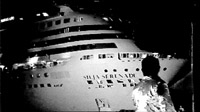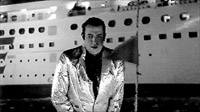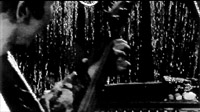A party is in progress with live salsa music. The guests seem to be enjoying themselves, and the band looks happy too (trumpet, drums, a couple of pretty girls swaying to maracas); everyone, in short is having a nice time - except the bandleader, a handsome fellow in a shiny gold suit who is scowling behind his guitar and looking as if he can't wait for the current number to be finished. The reason soon becomes apparent when our hero (in looks, a cross between Nicholas Cage and Bryan Ferry) dashes outside into the snowy evening air searching for a suitable place to urinate. There are a couple of makeshift cabins set up for the purpose; but it's crowded, and being leader of the band doesn't, unfortunately, guarantee a place at the front of the queue. What can he do but set off into the nearby woods for some privacy. There again, mischance: the spot our man alights upon is already in use – some squatting female revellers scatter at his approach, pulling up their knickers as they go. A polite and modest fellow, evidently, he heads for the neighbouring iceflow. Surely no one will disturb him there? Yet just as, unzipped and in full flow, he breathes a deep sigh of relief, the cruise ship Silja Serenade, lit up for a party, gently glides by – so close one could almost touch the passengers. Innocent enough you might think (if embarrassing), but in the ship's wake lies danger. The ice begins to crack and, in less time than it takes to blink, our hero is seated on an ice-clump, scrabbling in the shallows, one foot wedged in the ink-black ocean. And what's this he's fished up on the edge of his shoe? A wisp of netting, like organic candy floss, has become tangled round his lower calf, while entangled in it (as he discovers when he pulls further) is a fresh sea-salmon, still kicking. Surely such gifts from the sea should be taken freely? Erstwhile frustration turns to happiness as our hero bounds back across the drift-ice, salmon in hand. And now we see him back in the dance hall, relaxed on stage in charge of another number. Meanwhile, behind him, on top of the amplifier, and laid out on a pillow of ice, the mysterious fish is flapping quietly in its death throes. In front of any work of art, the human impulse is to look for a meaning. Before we can enjoy the said object, we need to think we know what the artist is driving at. As a matter of fact this is rather less often a problem than people think it is. Most art after all is made to be understood; the artist, in the majority of cases, goes to considerable pains to be lucid. But sometimes he fails (he can't carry it off; the thing is more obscure than he hopes it is). At other times, on the contrary, he wants not to be understood: it is part of the fun of the exercise. Like a lyric poem, the short film – especially, like this one, a film without dialogues – is a puzzle, a riddle, a rebus. And in this particular case, there is something else that is special. The artist in question is Finnish. Everyone knows (at least they think they do) that Finns are supposed to be odd. Finnish surrealism, then, with a dash of Latin America; a little bit warm, a little bit icy; bracing, astringent, a touch mocking (the film ends with a wink, not into the camera, but beyond it: towards some acquaintance or admirer of the bandleader on the dance floor). Friendly, perhaps, as much as mocking: as if to say Don't make too much of this. The movie doesn't need interpreting. Or does it? Can we appreciate it without saying what it means? A film, in a certain way, is a dream, and it's one of the properties of dreams that they exist, as it were, at the edge of sense. The fantastical series of arabesques that comprise their narrative momentum may always be peeled away, if we are lucky, to reveal a solid, unexceptionable first cause beneath. Or congeries of first causes (overdetermination, Freud called it: dreams thrive on mixture and muddle). Supposing this movie were a dream, we could ask ourselves what exactly we have here. The basic anxiety, the primary cause that triggers the incidents that follow, can be attached to the protagonist's overwhelming desire to urinate: a desire destined to be frustrated, of course, as long as he remains asleep, though solvable in the symbolic realm through the handy mechanism of wish-fulfilment. (The film starts with the frustration of not being able to piss; then solves this frustration by allowing the sleeper-protagonist to imagine he's doing so.) Two further classical dream ingredients are likewise woven into the narrative: embarrassment (that one will be seen exposing oneself - a variation on all those dream situations where one discovers that one's naked in a crowded concourse); and disgust, or bodily squeamishness, symbolised by the extrusion of netting that works its way up from under the ice, attaching itself like dogshit to the protagonist's polished party shoes. What is this thing exactly? At one level, of course, merely a fishing net; at another level, however, we can see it as objective correlative for the mesh of undifferentiated anxieties (physiological as much as mental: having to do with the stomach and intestines) that lurk at the edge of all dreams - making them at one and the same time vague and precise; saturated with meaning, and at the same time utterly trivial. And what's this that's caught in the netting? A fish: symbol of symbols, prince of signifiers. Any attempt to deconstruct such an obvious rebus is bound to be hopelessly literal. What is this slithery thing other than the unconscious itself? How we interpret it further than this depends on our private dispositions. Freud said the fish was a phallus (all dreams, according to Freudians, are about sex). Christians on the other hand - to take just one example among many - have made of it a symbol of their saviour (that juxtaposition is already surrealist). Different cultures have used different species of fish - the carp, the herring, the bream, the cod, the salmon - to point to different things about their deepest national appetites. (As I write this I become aware that I am, alas, hazy about which fish exactly Finns are supposed to be partial to.) It's not for nothing that animals of all sorts avail themselves so readily to the archetypal symbolising activity which surrounds, in the human world, investitures, crestings and heraldry. How we imagine animals in the deepest sense (how we live with them, in all senses of the word) is as old as language itself - maybe older. For they are man's companions, and it is not surprising, perhaps, that we should perpetually come back to dreaming about them. The congruity between films and dreaming which is present more or less in all cinema famously comes to the fore in certain great artists whom we know and love: Bunuel, Fellini, Bergman for example. There are wonderful films by each of these named directors that are, in essence, nothing but extended dream scenarios; such films live in the world of dream and can only be properly understood as part of this oneiric economy. Yet if there is any difficulty at all about this equivalence, it is that the length of the feature film pushes such objects beyond the usual time-span that dreams, in real life, take to unfold. How long is that? How long does a dream really last? Scientists measure these things by eye-movements, and divide our sleep up into the periods of dream activity flanked by periods of relative dormancy. I think however that our subjective experience of dreams is that they are usually of relatively brief duration (granted: it is often difficult to tell where one dreams stops and another begins). And this makes one feel that a short film is somehow a more natural vehicle for dream narrative than a fully developed feature such as The Phantom of Liberty (or Eight and a Half or The Hour of the Wolf). Yes, these things are subjective of course, and no hard and fast rule need to be attached to the matter. There was a time, in the infancy of cinema, when all films were short; and indeed part of the pleasure of seeing extinct and ghostly examples of early cinema (in annual exhibitions like Pordenone's Giornate del cinema muto) is that they have about them an atmosphere of fantasy and playful unpredictability that can only meaningfully be glossed as belonging to the realm of the unconscious. These days, the short film par excellence is the advertising commercial. Coming in at a minute to a minute and a half, such films are shorter, even, than the artistically independent genre of short film that we are dealing with here. (Las Nueve Vidas - a short short film - is just over four minutes long.) Are commercials also therefore linked to the dream economy we have been attempting to outline? Are they indeed of its essence? In a certain sense one wants to say yes: a case could be made for arguing that surrealism, if it lives anywhere at all nowadays, lives, exactly, in the polished, postmodernist experiments which constitute the modern movie commercial. (Incidentally, since commercials are not generally shown in American movie houses before the show, it's one aspect of cinema we Europeans can be proud to call our own.) On the other hand, the requirement that each miniature masterpiece of marketing should end up endorsing a single commercial product tells against its artistic stature in the long run. Does it not? Las Nueve Vidas is not, needless to say, a television commercial (though it remains true that the skills that have gone into making it are not so very different from the skills that would be needed to produce an interesting one minute spot). For real art, an audience needs to be free; it needs to be able to wonder; it needs, at times, not to get the point - or not to get the point all at once. So the sea-salmon lying on the amplifier is glimpsed in the background, rather than emphasised in importunate close-up. No propriety brand of fish product is stamped on its flank. In so far as the image may be said to have a function, that function is to tease us out of thought, like the frieze on the Grecian urn in Keats's famous Ode. Does the director himself really know what it signifies? And does it matter? There's mischief and fun in the film; and also something just a little bit intriguing.
| |||
|


